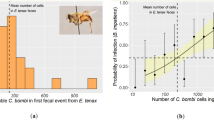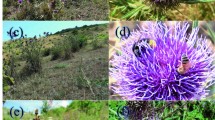Summary:
On flowers in the field we found the phoretic instars of four mite species usually associated with bumblebees (Hymenoptera: Apidae: Bombus spp.): Parasitellus fucorum, P. ignotus (Mesostigmata: Parasitidae), Hypoaspis (Pneumolaelaps) hyatti (Mesostigmata: Hypoaspididae), and Scutacarus acarorum (Prostigmata: Scutacaridae). In behavioural experiments we show that the phoretic instars of P. fucorum can actively transfer between flowers and foraging bumblebees. We also show that they survive on flowers for at least 24 hours. We conclude that mites associated with bumblebees can use flowers for horizontal transfer between host lineages. However, one mite associate of bumblebees, Kuzinia laevis (Astigmata: Acaridae), did not occur on flowers. This mite is small and attaches with an anal suckerplate, which may make transfer between flowers and foraging bumblebees impossible. S. acarorum, a mite of similar size to K. laevis, compensates for its limited mobility by using the larger mite P. fucorum as a vector.
Similar content being viewed by others
Author information
Authors and Affiliations
Additional information
Received 3 January 1997; revised 8 April 1997; accepted 9 June 1997.
Rights and permissions
About this article
Cite this article
Schwarz, H., Huck, K. Phoretic mites use flowers to transfer between foraging bumblebees . Insectes soc. 44, 303–310 (1997). https://doi.org/10.1007/s000400050051
Issue Date:
DOI: https://doi.org/10.1007/s000400050051




